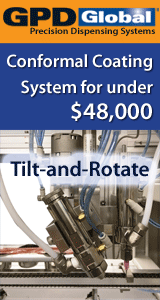Copper/Epoxy Joints in Printed Circuit Boards: Manufacturing and Interfacial Failure Mechanisms
Published: |
January 9, 2020 |
Author: |
Philipp Nothdurft, Gisbert Riess, Wolfgang Kern |
Abstract: |
PCBs have a wide range of applications in electronics where they are used for electric signal transfer. For a multilayer build-up, thin copper foils are alternated with epoxy-based prepregs and laminated to each other. Adhesion between copper and epoxy composites is achieved by technologies based on mechanical interlocking or chemical bonding, however for future development, the understanding of failure mechanisms between these materials is of high importance. In literature, various interfacial failures are reported which lead to adhesion loss between copper and epoxy resins. This review aims to give an overview on common coupling technologies and possible failure mechanisms. The information reviewed can in turn lead to the development of new strategies, enhancing the adhesion strength of copper/epoxy joints and, therefore, establishing a basis for future PCB manufacturing.... |
|
|
|
Company Information:
More SMT / PCB assembly technical articles »
- Apr 11, 2022 - iNEMI Webinar 07.07.2021 - PCB Cleaning | ZESTRON Americas

- Jan 28, 2022 - Open Radio Unit White Box 5G | Whizz Systems

- Nov 10, 2021 - Understanding the Cleaning Process for Automatic Stencil Printers | ITW EAE

- Oct 20, 2021 - PCB Surface Finishes & The Cleaning Process - A Compatibility Study | ZESTRON Americas

- Oct 06, 2021 - Cleaning Before Conformal Coating | ZESTRON Americas

- Browse Technical Library »
Copper/Epoxy Joints in Printed Circuit Boards: Manufacturing and Interfacial Failure Mechanisms article has been viewed 841 times







